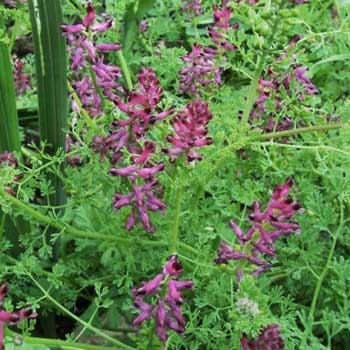Contents:
Common Names | Parts Usually Used | Plant(s) & Culture | Where Found | Medicinal Properties | Biochemical Information
Legends, Myths and Stories | Uses | Formulas or Dosages | Bibliography
Scientific Names

- Fumaria officinalis L.
- Fumariaceae
- Fumitory family
Common Names
- Earth smoke
- Hedge fumitory
- Scabweed
Parts Usually Used
Flowering herb
Back to Top
Description of Plant(s) and Culture
Fumitory is an annual, slender, climbing plant; the sub-erect, hollow stem is angular, smooth, and bluish or smoky-green colored. The leaves are frail, alternate, gray-green, and bipinnate or tripinnate with small, narrow divisions. The small flowers vary from reddish-purple to yellowish-white, and have a reddish-black spot at the tip, grow in loose racemes from May to September.
Back to Top
Where Found
Grows practically everywhere on earth, mostly around areas where other plants are cultivated. Fumitory is native to Europe.
Back to Top
Medicinal Properties
Alterative, cholagogue, diuretic, laxative, stomachic, bitter tonic
Back to Top
Biochemical Information
Fumarine and other alkaloids, fumaric acid, bitter principles, resin, mucilage
Back to Top
Legends, Myths and Stories
According to the Webster’s Dictionary the classification of fumitory is of the fumitory family. But some references claim it belongs to the poppy family or Papaveraceae.
Fumitory was mentioned by Pliny, the Roman writer (AD 23-79) and by Dioscorides, a Greek physician (first century AD). One of fumitory’s common German names once was scabweed.
Back to Top
Uses
Fumitory is primarily used internally for liver and gallbladder problems, scabies, jaundice, and other skin problems, dermatitis, stomach disorders, cures nausea, vomiting, and exanthema. Larger doses act as a laxative and diuretic, but excessive doses can cause diarrhea and stomachache. For chronic constipation, use fumitory in combination with other appropriate herbs. Taken as a blood purifier. As Culpeper states it: it clarifies “the blood from saltish, choleric, and adust humours; which cause leprosy, scabs, tetters, and itches; and such like breakings-out of the skin, and after the purgings doth strengthen all the inward parts”. He also thought it protected against the plague and pestilence.
Culpeper states, “The juice of the fumitory and docks mingled therewith, cures all sorts of scabs, pimples, blotches, wheals, and pushes which arise on the face or hands, or any other parts of the body”.
Back to Top
Formulas or Dosages
Use the dried herb.
Infusion: steep 1 heaping tsp. herb in 1 cup water. Take cold, a wineglassful at a time, every 4 hours.
Cold extract: use 1 tsp. herb with 1/2 cup cold water. Let stand for 8-10 hours. Take 1/2 to 1 cup per day.
Tincture: take 1/2 to 1 tsp. at a time.
Back to Top
Bibliography
![]() American Folk Medicine
American Folk Medicine, by Clarence Meyer, Meyerbooks, publisher, PO Box 427, Glenwood, Illinois 60425, 1973
![]() The Complete Medicinal Herbal
The Complete Medicinal Herbal, by Penelope Ody, Dorling Kindersley, Inc, 232 Madison Avenue, New York, NY 10016, First American Edition, copyright 1993
![]() Culpeper’s Complete Herbal & English Physician: Updated With 117 Modern Herbs
Culpeper’s Complete Herbal & English Physician: Updated With 117 Modern Herbs, by Nicholas Culpeper, Meyerbooks, publisher, PO Box 427, Glenwood, Illinois 60425, 1990, (reprint of 1814)
 The Healing Plants
The Healing Plants, by Mannfried Pahlow, Barron’s Educational Series, Inc. 250 Wireless Blvd., Hauppauge, NY 11788, 1992
![]() The Herbalist Almanac
The Herbalist Almanac, by Clarence Meyer, Meyerbooks, publisher, PO Box 427, Glenwood, Illinois 60425, copyright 1988, fifth printing, 1994
![]() The Herb Book
The Herb Book, by John Lust, Bantam Books, 666 Fifth Avenue, New York, NY. copyright 1974.
Herbal Gardening, compiled by The Robison York State Herb Garden, Cornell Plantations, Matthaei Botanical Gardens of the University of Michigan, University of California Botanical Garden, Berkeley., Pantheon Books, Knopf Publishing Group, New York, 1994, first edition
 The Magic of Herbs
The Magic of Herbs, by David Conway, published by Jonathan Cape, Thirty Bedford Square, London, England. (Out of print)
![]() Planetary Herbology
Planetary Herbology, by Michael Tierra, C.A., N.D., O.M.D., Lotus Press, PO Box 325, Twin Lakes. WI 53181., Copyright 1988, published 1992
![]() Webster’s New World Dictionary
Webster’s New World Dictionary, Third College Edition, Victoria Neufeldt, Editor in Chief, New World Dictionaries: A Division of Simon & Schuster, Inc., 15 Columbus Circle, New York, NY 10023
